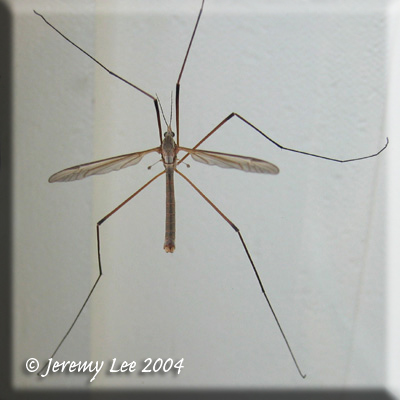
 |
|
Scientific Classifications explained » Amphibians » Ants » Aphids » Bees » Beetles » Birds » Bugs » Butterflies » Caterpillars » Damselflies » Dragonflies » Earwigs » Flies » Frog/Leafhoppers » Fungi » Galls » Grasshoppers » Harvestmen » Hoverflies » Lacewings » Ladybirds » Leaf Mines » Lichens » Mammals » Millipedes » Mosses » Moths » Sawflies » Slugs » Snails » Spiders » Trees & Shrubs » Wasps » Wild Flowers » Woodlice » Postboxes |
UK Nature > Flies > Tipula paludosa

Scientific Name: Tipula paludosa Common Name: Crane Fly Tipula paludosa, more commonly known as a Crane Fly or Daddy Long Legs (in the UK), is about 25mm long and have very fragile legs, which can easily break off during handling (the male shown above has one left leg missing). The male has a swollen tip to his abdomen, but the female has a pointed tip which she uses to push her eggs into the soil. The larvae are the infamous root eating "leatherjackets", much disliked by gardeners everywhere. They also come to the surface at night and chew the base of stems. Large numbers may live under the lawn. Adult flies rarely feed. They are on the wing for most of the year, but most common in autumn when they swarm over our lawns and come to lighted windows at night. They rest with their wings outstretched and are commonly seen on house and garden walls. Found throughout the UK in parks, gardens and grasslands of all kinds. T. oleracea is similar, but most common in Spring. |
|

https://www.uknature.co.uk is a website dedicated to showing the immense diversity of UK nature and wildlife. Our vast range of habitats, from lowland arable to snow covered mountains, from storm-ravaged coastlines to peaceful inland freshwater lakes and rivers, from dry, sandy heaths to deciduous and coniferous forests, all these habitats contribute to the abundance of UK nature. We have wild birds in huge numbers either residing or visiting our shores (597 recorded species as at July 2013) and we must also not forget the humble back garden with its grass lawns, flower beds filled with nectar rich flowers, shrubs and trees, all designed to attract huge numbers of insects such as bees, moths, butterflies and hoverflies; and finally the small ponds which provide safe havens for frogs, toads, newts and even slow worms and grass snakes. www.uknature.co.uk is the showcase for my personal passion, photographing uknature in all its glory. I sincerely hope you all enjoy the fruits of my labours. This site and all images contained therein is © Jeremy Lee 2004 - 2025. All Rights Reserved. Site design by Jeremy Lee. Site development & IT Support by Stuart Lee. |